70mm in Mexico City |
Read more
at in70mm.com The 70mm Newsletter |
| Written by: Miguel Carrara, Mexico. Translated and Edited by Michael Coate | Date: 12 June 2005 |
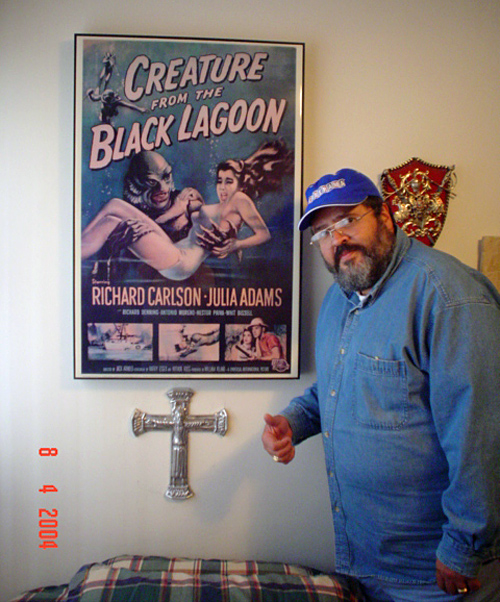 The
author of the
article The
author of the
articleMexican citizens have often been disappointed with the actions of their government, which they believe have been too involved with all aspects of the lives of its people...including their motion picture entertainment. The Mexican movie going public was not able to experience deluxe 70-millimeter and Cinerama presentations until many years after those innovations had been introduced in other countries around the world. However, once 70mm came to Mexico, a LOT of movies were shown in the large format, including several American and British productions seen in their country of origin only in 35mm versions. Many decades ago, several grand movie palaces were built throughout Mexico City, much to the delight of moviegoers. These palaces were constructed and designed with a variety of styles from around the globe. It was not uncommon to find the auditoriums decorated with elaborate statues, paintings or candelabras. Perhaps the greatest cinema was the Flowery, which featured an art deco style and could seat nearly 7,000. During the 1950s and the widescreen revolution, many of the Mexican cinemas capitalized on the trend and installed some of the new innovations being introduced. First to arrive in Mexico was 3-D and with it "Bwana Devil". The 3-D format, however, was not successful in Mexico and disappeared not long after its introduction. CinemaScope, on the other hand, was a resounding success. 'Scope arrived in Mexico in December 1953, only three short months after the process premiered in the United States. As in the U.S., "The Robe" was the first scope film exhibited. By the middle of 1954, nearly every Mexican cinema had been outfitted with a new, larger and wider screen and a set of anamorphic CinemaScope projection lenses. Magnetic four-channel sound systems were, surprisingly, installed in quite a number of the scope cinemas, including many neighbourhood cinemas. Unfortunately, the government intervened during this period and, in an attempt to be popular with the majority of the citizens, established a ceiling for ticket prices. While this restriction allowed the average citizen to afford attending movies on a regular basis, it delayed the installation of expensive innovations such as Todd-AO and Cinerama since a necessary and desirable hike in admissions could not be enforced. Cinerama was late to arrive in Mexico. It had premiered in America in 1952, but by the time it was installed in Mexico in 1967, no more films were being produced in the three-strip format. The 70mm format had much greater success in Mexico, but too was late in its arrival. It had been announced that Todd-AO 70mm would arrive in 1960, and the debut attraction was to be "Solomon and Sheba". But due to the government's restriction on an increase in ticket prices for deluxe attractions (higher admission prices being common in other countries, particularly in Europe and parts of Latin America), "Solomon and Sheba" was shown in 35mm. Other productions from the early 1960s with 70mm print availability ("The Alamo", "Black Tights", "The Man with the Green Carnation", "The Savage Innocents", etc.) also were shown in Mexico in 35mm versions. The 70mm presentation format would finally be seen in Mexico City in 1962, seven years following its debut in New York, with the grand opening of the Cine Diana, in which the necessary projection and sound equipment was installed. Along with 70mm's arrival to the Mexican capital, the government allowed an 8 peso ceiling on admission to the Cine Diana (and subsequent 70mm venues) when screening 70mm prints. This was compared with a 4 peso ceiling for regular movie houses. Based upon the international exchange rate during the 1960s, one peso was equal to about eight to ten cents ($U.S.) at the time. 70mm in Mexico City... What follows is a cinema-by-cinema list of films exhibited in Mexico City in the 70-millimeter six-track stereophonic sound format. The information is based upon me attending the films, cataloguing my movie going experiences, and researching the engagement history in the local newspapers archived on microfilm. The titles have been listed in English, and although the premiere dates have not been included (they may be added in a revision), the titles are listed in their original exhibition order. I moved to Europe in 1976. However, I returned to Mexico for holiday visits and continued to attend many films shown in 70mm, and such films are included here. |
Further
in 70mm reading: 70mm Films shown in Mexico Seeing 70mm in Mexico 70mm Premiere of "Jesus Christ Superstar" in Madrid Curiosities from Mexico Internet link: |
Cine Diana |
|
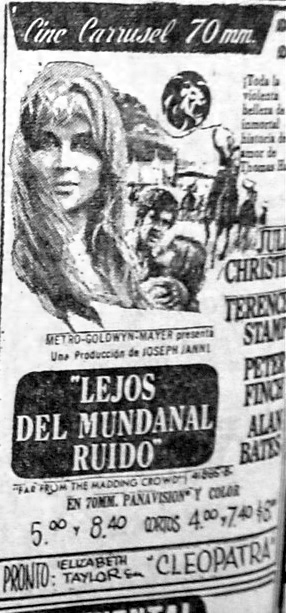 This beautiful movie
palace opened in May
1962 and featured
elegant, magnificent
decor by famed
Mexican artist
Manuel Felguerez.
The Cine Diana had a
large Todd-AO
screen, around 2,000
seats, and superb
six-track stereo
sound. In fact, the
audio presentation
quality was among
the very best I
experienced anywhere
in the world. The
first 70mm
presentation at this
cinema (and the
first in Mexico
City) was
"Spartacus"
in 1962; the final
70mm show was
"A Chorus
Line" in
1985. Today, this is
just another typical
eight-screen
multiplex. This beautiful movie
palace opened in May
1962 and featured
elegant, magnificent
decor by famed
Mexican artist
Manuel Felguerez.
The Cine Diana had a
large Todd-AO
screen, around 2,000
seats, and superb
six-track stereo
sound. In fact, the
audio presentation
quality was among
the very best I
experienced anywhere
in the world. The
first 70mm
presentation at this
cinema (and the
first in Mexico
City) was
"Spartacus"
in 1962; the final
70mm show was
"A Chorus
Line" in
1985. Today, this is
just another typical
eight-screen
multiplex.Films shown at the Cine Diana in 70mm: Spartacus (USA / Super Technirama 70) Exodus (USA / Super Panavision 70) Can-Can (USA / Todd-AO) Barabbas (Italy-USA / Super Technirama 70) West Side Story (USA / Super Panavision 70) El Cid (Italy-USA / Super Technirama 70) Lawrence of Arabia (UK / Super Panavision 70) Taras Bulba (USA-Yugoslavia / Blow-Up) The Fall Of The Roman Empire (USA / Ultra Panavision 70) Porgy and Bess (USA / Todd-AO) Becket (UK-USA / Blow-Up) The Cardinal (USA / Blow-Up) Circus World (USA / Super Technirama 70) My Fair Lady (USA / Super Panavision 70) It's A Mad Mad Mad Mad World (USA / Ultra Panavision 70) Scheherazade (France-Italy-Spain / MCS Superpanorama 70) The Great Race (USA / Blow-Up) Doctor Zhivago (USA / Blow-Up) The Bible (Italy-USA / Dimension-150) Doctor Dolittle (USA / Todd-AO) Battle of the Bulge (USA / Ultra Panavision 70) Guns for San Sebastian (France-Italy-Mexico / Blow-Up) The Greatest Story Ever Told (USA / Ultra Panavision 70) Camelot (USA / Blow-Up) Valley of the Dolls (USA / Blow-Up) Far from the Madding Crowd (UK / Blow-Up) Star! (USA / Todd-AO) The Great Wall (Japan / Super Technirama 70) Anna Karenina (USSR / Sovscope 70) Cheyenne Autumn (USA / Super Panavision 70) Hell in the Pacific (USA / Blow-Up) Krakatoa East of Java (USA / Super Panavision 70) Emiliano Zapata (Mexico / Blow-Up) Paint Your Wagon (USA / Blow-Up) Too Late the Hero (USA / Blow-Up ) The Battle of Britain (UK / Blow-Up) The Andromeda Strain (USA / Blow-Up) On A Clear Day You Can See Forever (USA / Blow-Up) Murphy's War (UK-USA / Blow-Up) Hannie Caulder (UK / Blow-Up) Rollerball (USA / Blow-Up) A Chorus Line (USA / Blow-Up) |
|
Cine Manacar |
|
 The Cine Manacar,
which opened
in April 1965, was
elegant and very
modern. Attributes
included a great
Todd-AO screen
situated behind
beautiful curtains
of four sliding
panels painted by
Carlos Merida, about
2,000 seats, and
good six-channel
sound (though not as
impressive as the
sound system at the
Diana). The first
70mm show was
"How the
West was Won"
in 1965 which, since
Cinerama had not yet
come to Mexico, was
converted from
three-panel Cinerama
to a composite 70mm
version. The final
70mm engagement was
"Sgt.
Pepper's Lonely
Hearts Club Band"
in 1979. And worth
noting, the Cine
Manacar has the
honorable
distinction of
having hosted the
longest-running
season in Mexican
cinema history: 65
weeks of...(are you
surprised?)..."The
Sound of Music".
Today: an awful
multiplex of 11
screens. The Cine Manacar,
which opened
in April 1965, was
elegant and very
modern. Attributes
included a great
Todd-AO screen
situated behind
beautiful curtains
of four sliding
panels painted by
Carlos Merida, about
2,000 seats, and
good six-channel
sound (though not as
impressive as the
sound system at the
Diana). The first
70mm show was
"How the
West was Won"
in 1965 which, since
Cinerama had not yet
come to Mexico, was
converted from
three-panel Cinerama
to a composite 70mm
version. The final
70mm engagement was
"Sgt.
Pepper's Lonely
Hearts Club Band"
in 1979. And worth
noting, the Cine
Manacar has the
honorable
distinction of
having hosted the
longest-running
season in Mexican
cinema history: 65
weeks of...(are you
surprised?)..."The
Sound of Music".
Today: an awful
multiplex of 11
screens. |
|
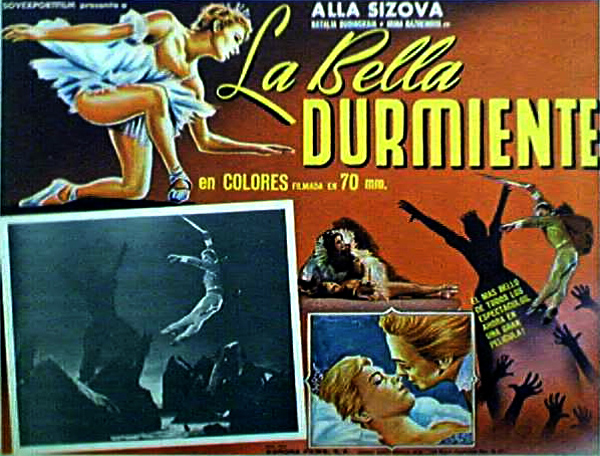 How the West
was Won
(USA /
Cinerama-to-composite
70mm) How the West
was Won
(USA /
Cinerama-to-composite
70mm)Lord Jim (UK-USA / Super Panavision 70) Cleopatra (USA / Todd-AO) The Long Ships (USA-Yugoslavia / Super Technirama 70) The Flying Clipper (West Germany / MCS Superpanorama 70) The Sound of Music (USA / Todd-AO) Those Magnificent Men in their Flying Machines (UK / Todd-AO) The Agony and the Ecstasy (USA / Todd-AO) Is Paris Burning? (France-USA / Blow-Up) Khartoum (UK / Ultra Panavision 70) The Black Tulip (France-Italy-Spain / MCS Superpanorama 70) The Sand Pebbles (USA / Blow-Up) The Comedians (France-USA / Blow-Up) Half A Sixpence (UK / Blow-Up) Uncle Tom's Cabin (France-Italy-West Germany-Yugoslavia / MCS Superpanorama 70) |
|
|
Finian's Rainbow (USA / Blow-Up) Custer of the West (France-UK-USA / Super Technirama 70) Sweet Charity (USA / Blow-Up) The Monte Carlo Rally (France-Italy-UK / Blow-Up) Gone with the Wind (USA / Blow-Up / "Now in Wide Screen and the Wonder of 70mm") The Young Girls of Rochefort (France / Blow-Up) The Great Caruso (USA / Blow-Up / "Now in Wide Screen and the Wonder of 70mm") Around the World in Eighty Days (USA / Todd-AO / First time in 70mm in Mexico) Russian Adventure (USSR / Cinerama-to-composite 70mm) Darling Lili (USA / Blow-Up) Tchaikovsky (USSR / Sovscope 70) Sleeping Beauty (USA / Super Technirama 70 / First time in 70mm in Mexico) Hellfighters (USA / Blow-Up) The Brothers Karamazov (USSR / Sovscope 70) Four Flies on Grey Velvet (France-Italy / Blow-Up) Mary, Queen of Scots (UK / Blow-Up) Ben-Hur (USA / MGM Camera 65 / First time in 70mm in Mexico) The Boyfriend (UK / Blow-Up) The Great Circus Parade (USSR / Sovscope 70) The Ten Commandments (USA / VistaVision / "Now in Wide Screen and the Wonder of 70mm") Swan Lake (USSR / Sovscope 70) Click image to see enlargement |
*) I think, that is not a MCS Superpanorama 70 film as is written there. It is an UltraScope film (Cinematographic process), film negativ 35mm in this case a 70mm blow up. Gerhard Witte, Berlin |
 Sunflowers
(Italy-USSR /
Sovscope 70) Sunflowers
(Italy-USSR /
Sovscope 70)The Hawaiians (USA / Blow-Up) Jesus Christ Superstar (USA / Blow-Up) Romeo and Juliet (Italy-UK / 1968 / Blow-Up / "Now in 70mm") The Poem of Dance (USSR / Sovscope 70) Julius Caesar (UK / 1970 / Blow-Up) The Blood Spattered Bride (Spain / "70mm. Wide Screen") Antony and Cleopatra (Spain-Switzerland-UK / Blow-Up) Mame (USA / Blow-Up) Goya (USSR / Sovscope 70) Sgt. Pepper's Lonely Hearts Club Band (USA / Blow-Up) |
|
Cine Carrusel |
|
 The third
70mm-equipped venue
in the capital city,
this cinema opened
in April 1965
shortly following
the Cine Manacar.
The cinema had an
enormous gray
auditorium but with
limited decor. The
screen was larger
than most. The
cinema could seat
close to 3,000 and
is noted for its
many bookings of
Soviet and other
international films.
Today, a highway and
subway terminal sit
in the demolished
cinema's place. The third
70mm-equipped venue
in the capital city,
this cinema opened
in April 1965
shortly following
the Cine Manacar.
The cinema had an
enormous gray
auditorium but with
limited decor. The
screen was larger
than most. The
cinema could seat
close to 3,000 and
is noted for its
many bookings of
Soviet and other
international films.
Today, a highway and
subway terminal sit
in the demolished
cinema's place.Imperial Venus (France-Italy / Super Tecnirama 70) Antinea, Siren of Atlantis (France-Italy / Super Technirama 70) The Savage Pampas (Argentina-Spain-USA / MCS Superpanorama 70) The Hallelujah Trail (USA / Ultra Panavision 70) Buddha (Japan / Super Technirama 70) War and Peace (Part I / USSR / Sovscope 70) The Sleeping Beauty (USSR / Sovscope 70) The Third Youth (USSR / Sovscope 70) The Two of Us (USSR / Sovscope 70) An Optimistic Tragedy (USSR / Sovscope 70) The Law of the Antarctic (USSR / Sovscope 70) The Tale of Tsar Saltan (USSR / Sovscope 70) The Three Fat Ones (USSR / Sovscope 70) War and Peace (Part II / USSR / Sovscope 70) The Flaming Years (USSR / Sovscope 70) A Hero of our Times (USSR / Sovscope 70) Around the World Under the Sea (USA / Blow-Up) Seven Brides for Seven Brothers (USA / "Now in the Splendor of 70mm") Julius Caesar (USA / 1953 / "Now in 70mm Wide Screen") From 1976 onward, many 70mm revivals of popular films were screened, including "Can-Can", "El Cid", and "The Sand Pebbles". |
|
Hollywood Cinerama |
|
 Opened April 1967. Opened April 1967.Bravo! At last! After a fifteen-year delay, Cinerama arrived in Mexico with a wonderful Cinerama Dome surrounded by a golden curtain and over 1,000 seats. This cinema featured one of the largest screens I ever saw (and I've been to numerous Cinerama venues across the world). But despite the big news and appeal of Cinerama's arrival in Mexico, only one three-panel film was ever shown: "This is Cinerama". Following the "This is Cinerama" season, 70mm presentations began to be shown, and they were often promoted, in enjoyable hype of the era, as "70mm with Cinerama lenses on the biggest and best screen in the world". Genghis Khan (UK-USA-West Germany-Yugoslavia / Blow-Up) Casino Royale (UK-USA / Blow-Up) The Taming of the Shrew (Italy-UK / Blow-Up) Who Cares What They Say? (Spain / "70/mm. Widescreen") Guess Who's Coming To Dinner (USA / Blow-Up) In Cold Blood (USA / Blow-Up) Oliver! (UK / Blow-Up) Funny Girl (USA / Blow-Up) Marooned (USA / Blow-Up) MacKenna's Gold (USA / Super Panavision 70) The End of the Barbarians (West Germany-Yugoslavia / Blow-Up) The Last Valley (UK / Todd-AO) Murphy's War (UK-USA / Blow-Up) Cromwell (UK / Blow-Up) Tora! Tora! Tora! (Japan-USA / Blow-Up) Nicholas and Alexandra (UK / Blow-Up) The Hindenburg (USA / Blow-Up) Blind Terror (USA / "70mm Wide Screen") Funny Lady (USA / Blow-Up) Star Wars (USA / Blow-Up) Close Encounters of the Third Kind (USA / Blow-Up) Alien (UK-USA / Blow-Up) The Empire Strikes Back (USA / Blow-Up) Close Encounters of the Third Kind ("The Special Edition" re-issue) |
|
Latino D-150 |
|
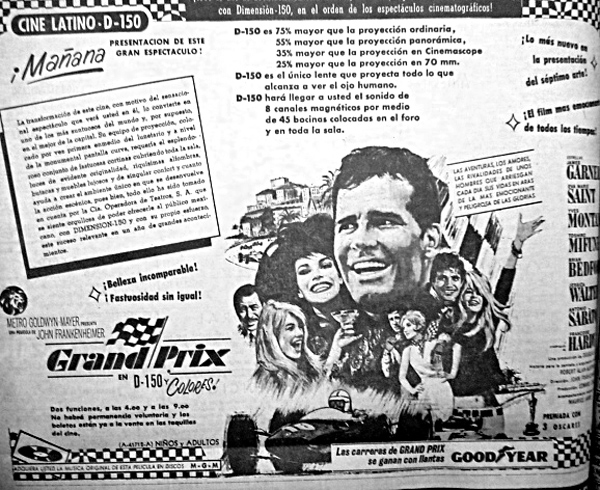 This cinema was
refurbished into a
deluxe Dimension-150
venue and re-opened
in January 1968. The
D-150 set-up looked
essentially the same
as any Cinerama
set-up. The 70mm
presentations were
good with adequate
projection quality
and okay sound. The
films were often
billed as a
"Dimension-150 70mm
Presentation".
Today, the cinema is
closed though still
standing. Can anyone
come to the rescue
of the cinema? This cinema was
refurbished into a
deluxe Dimension-150
venue and re-opened
in January 1968. The
D-150 set-up looked
essentially the same
as any Cinerama
set-up. The 70mm
presentations were
good with adequate
projection quality
and okay sound. The
films were often
billed as a
"Dimension-150 70mm
Presentation".
Today, the cinema is
closed though still
standing. Can anyone
come to the rescue
of the cinema?Grand Prix (USA / Super Panavision 70) 2001: A Space Odyssey (UK-USA / Super Panavision 70) Mayerling (UK / Blow-Up) Ice Station Zebra (USA / Super Panavision 70) Chitty Chitty Bang Bang (UK / Super Panavision 70) The Olympics in Mexico (Mexico / Blow-Up) The Lion in Winter (UK / Blow-Up) Where Eagles Dare (USA / Blow-Up) Goodbye, Mr. Chips (UK-USA / Blow-Up) Airport (USA / Todd-AO) Waterloo (Italy-USSR / Blow-Up) Ryan's Daughter (UK / Super Panavion 70) Anne of the Thousand Days (UK / Blow-Up) Fiddler on the Roof (USA / Blow-Up) Earthquake ((USA / Blow-Up / Sensurround) The Wiz (USA / Blow-Up) Hair (USA / Blow-Up) Apocalypse Now (USA / Blow-Up) |
|
Cine Olimpia |
|
 Dating back to the
1920s, this is the
oldest cinema in
Mexico City.
Refurbished and
re-opened in January
1968, this was given
a whole new look. In
its refurbished
form, this featured
a great Todd-AO
screen, about 1,500
seats, and decent
projection and sound
quality. Today the
building is closed
though still
standing. Dating back to the
1920s, this is the
oldest cinema in
Mexico City.
Refurbished and
re-opened in January
1968, this was given
a whole new look. In
its refurbished
form, this featured
a great Todd-AO
screen, about 1,500
seats, and decent
projection and sound
quality. Today the
building is closed
though still
standing.The Dirty Dozen (USA / Blow-Up) The Shoes of the Fisherman (USA / Blow-Up) Winning (USA / Blow-Up) Alfred the Great (UK / Blow-Up) Once Upon A Time in the West (Italy-USA / Blow-Up) Cervantes, The Young Rebel (France-Italy-Spain / Blow-Up) Good Time Girls (Spain / "70mm Wide Screen") The Story of Simon Bolivar (Italy-Spain-Venezuela / MCS Superpanorama 70) The Virgin and the Gypsy (UK / Blow-Up) The Novice Dreamer (Spain / "70mm Wide Screen") Vaudeville Show (Spain / "70mm Wide Screen") Petroleum Girls (France-Italy-Spain-UK / Blow-Up) The Christ of the Ocean (Spain / "70mm Wide Screen") Goodbye, Birth Stork, Goodbye (Spain / "70mm Wide Screen") The Music Lovers (UK / Blow-Up) |
|
Cine Futurama |
|
|
Opening for business
in 1968, the Cine
Futurama was a big,
elegant, and modern
moviegoing palace
with beautiful
glass, carved decor
and lighting.
Unfortunately, it
was located in a
very distant
suburban area which
made it difficult to
reach from the
central parts of the
city. As a
consequence, the
theatre had a
limited number of
first-run bookings
and when showing
70mm they typically
had already been
screened elsewhere
in the city. As for
the presentation,
projection and sound
quality were
excellent, and fans
of the 70mm format
usually made the
extra effort to
attend. The cinema
was demolished, with
a "cultural mall"
(library, coffee
shops, new theatres,
etc.) currently
residing in its
place. The Battle of Neretva (Italy-USA-West Germany-Yugoslavia / Blow-Up) Zulu (UK / Super Technirama 70) Raid on Rommel (USA / Blow-Up) Oh! What A Lovely War (UK / Blow-Up) The Wild Bunch (USA / Blow-Up) Elvis: That's The Way It Is (USA / Blow-Up) I Come, I Watch, I Shoot ( Italy-Spain / Blow-Up) Liberation (USSR / Sovscope 70) Wild Rovers (USA / Blow-Up) Wrath of the Wind (Italy-Spain / MCS Superpanorama 70) The Ten Commandments (USA / VistaVision / "Now in Wide Screen and the Wonder of 70mm") |
|
Cinema Insurgentes 70 |
|
|
Another old
movie house which
originally opened in
1943. It was
completely
refurbished and
re-opened in
September 1969. The
cinema featured a
curved Cinerama-type
screen and decent
stereo sound.
Unfortunately, they
ran very few 70mm
prints. The Battle for Anzio (France-Italy-Spain-USA / Blow-Up) The Horsemen (USA / Super Panavision 70 & Blow-Up) El Golfo (Mexico-Spain / Blow-Up) MacKenna's Gold (re-issue) The Long Ships (re-issue) |
|
Las Torres Super-Heraclorama |
|
 Click
image to see enlargement Click
image to see enlargementVery big! Very cold! Very odd! And always empty! This cinema opened in January 1970 in another far-off suburban area. Presentation-wise, this had the largest screen I ever saw. The Heraclorama process (never heard of it before or after) was a very large semicircular screen with foggy images and a notable lack of clarity. Sound quality was okay. The cinema survived by showing many re-releases and revivals. After being in business as a first-run house, the theatre showed plays and musicals. For a while it was a multiplex and is now closed. Shalako (UK-West Germany / Blow-Up) Catherine (France-Italy-West Germany / Blow-Up) A Man Called Horse (USA / Blow-Up) The Robe (USA / Blow-Up / "Now in the Splendor of 70mm") The Longest Day (USA / Blow-Up / "Now in the Splendor of 70mm") The Great Silence (Italy-Spain / Blow-Up) Duel in the Sun (USA / Blow-Up / "Now in the Wonder of 70mm") The Royal Hunt of the Sun (UK-USA / Blow-Up) Scrooge (UK / Blow-Up) El Cid (re-issue) My Fair Lady (re-issue) The Sound of Music (re-issue) Lawrence of Arabia (re-issue) Barabbas (re-issue) |
|
Cine Las Americas |
|
|
An enormous palace
that originally
opened in 1954, it
was refurbished into
a 70mm venue in
1970. The interior
was an elegant green
and gold. The cinema
showed only a
handful of 70mm
presentations,
though it lasted as
a cinema for many
years. In recent
time, it was used as
a casino and a
wrestlers arena. Kelly's Heroes (USA / Blow-Up) The Red Tent (Italy-USSR / Sovscope 70) The Devils (UK / Blow-Up) The Great Waltz (USA / Blow-Up) The Residence (Spain / "70mm. Wide Screen") Michael Strogoff (France-Italy / MCS Superpanorama 70) The Red Sun (France-Italy-Spain / "70mm. Wide Screen") The Hill of the Dead (Italy-Spain / "70mm. Wide Screen") The Black Hole (USA / Blow-Up) Tron (USA / Super Panavision 70) |
|
Cinema El Dorado 70 |
|
 Opening in April
1970, this was the
first cinema in
Mexico City to be
built within a
commercial plaza
(shopping mall).
This was a large,
Cinerama Dome-style
cinema featuring
excellent
presentations. As
with most of the
other cinemas to
open in the early
1970s, they screened
few 70mm prints
since the format was
in a decline during
that period of time.
Today, this is an
eight-screen multiplex,
including two large
auditoriums (by
today's standards)
and Digital Cinema
projection
capability. Opening in April
1970, this was the
first cinema in
Mexico City to be
built within a
commercial plaza
(shopping mall).
This was a large,
Cinerama Dome-style
cinema featuring
excellent
presentations. As
with most of the
other cinemas to
open in the early
1970s, they screened
few 70mm prints
since the format was
in a decline during
that period of time.
Today, this is an
eight-screen multiplex,
including two large
auditoriums (by
today's standards)
and Digital Cinema
projection
capability.Hello, Dolly! (USA / Todd-AO) The Southern Star (France-UK / Blow-Up) Song of Norway (USA / Super Panavision 70) Patton (USA / Dimension-150) The Light at the Edge of the World (Liechtenstein-Spain-Switzerland-USA / Blow-Up) Tora! Tora! Tora! (re-issue) |
|
Cinema Ciudadela 70 |
|
|
This opened in
April 1971 and was similar in design as the El Dorado 70. The Poseidon Adventure (USA / Blow-Up) |
|
Cinema Plaza Statelite 70 |
|
|
Also similar in
design to the El
Dorado 70, this
opened in October
1971. At the time,
this was located in
a far-off suburban
area. But today,
since the city has
expanded so much,
the area of its
locale is not so
much considered
far-off. Today, this
is a multiplex. Le Mans (USA / Blow-Up) The Sound of Music (re-issue) The Rose (USA / Blow-Up) |
|
Cinema Pedregal 70 |
|
|
Opened September
1972. Quo Vadis (USA / "Now in the Splendor of 70mm. and Wide Screen") |
|
Cinema La Raza 70 |
|
|
The only known 70mm
engagements were
revival showings of
"A Man
Called Horse"
and "The
Robe". |
|
Cinema Imperial 70 & Cinema Tlaloc 70 |
|
|
These cinemas were
promoted as having
70mm projection
capability, but I am
unaware of any 70mm
screenings. |
|
Cineteca Nacional |
|
|
Opening in January
1974, this was the
venue used by the
Mexican
Cinematheque. A
modern design with
nice but minimal
decor, this featured
excellent
presentation
quality.
Unfortunately, this
cinema was destroyed
by a fire. It was
rebuilt, though the
modern version does
not include 70mm
projection
capability. That's Entertainment! (USA / Blow-Up) Casino Royale (Shown during a Woody Allen retrospective) The Leopard (France-Italy / Super Technirama 70 / Shown during a Luchino Visconti retrospective) Solaris (USSR / Sovscope 70) Dersu Uzala (Japan-USSR / Sovscope 70) |
|
Auditorio plaza |
|
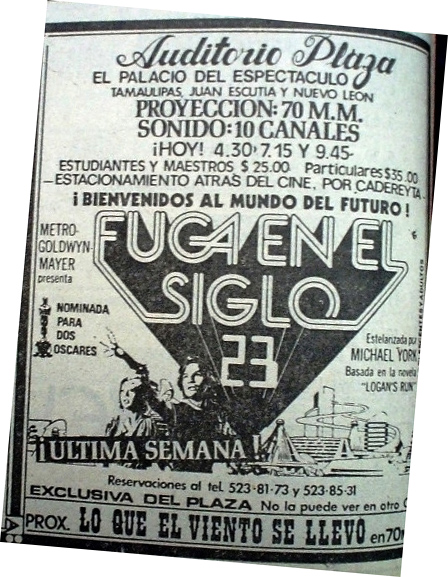 A fine example of
Mexican chaos! Just
when the multiplex
concept was
spreading, someone,
amazingly, decided
to bring back to
life the classic
single-screen idea.
This cinema had lay
dormant for decades
after a previous
project, the Cine
Astoria, failed to
be completed. It was
completed and opened
as the Auditorio
Plaza in January
1977. Very large,
very tall, very
cold, and most of
the time, empty.
They even boasted an
elevator for the
upper level and
balcony. Excellent
presentation
quality! A shame
that only a few 70mm
prints were ever
screened. Today, the
theatre is closed. A fine example of
Mexican chaos! Just
when the multiplex
concept was
spreading, someone,
amazingly, decided
to bring back to
life the classic
single-screen idea.
This cinema had lay
dormant for decades
after a previous
project, the Cine
Astoria, failed to
be completed. It was
completed and opened
as the Auditorio
Plaza in January
1977. Very large,
very tall, very
cold, and most of
the time, empty.
They even boasted an
elevator for the
upper level and
balcony. Excellent
presentation
quality! A shame
that only a few 70mm
prints were ever
screened. Today, the
theatre is closed.Logan's Run (USA / Blow-Up) That's Entertainment, Part II (USA / Blow-Up) Return of the Jedi (USA / Blow-Up) Blue Thunder (USA / Blow-Up) The Star Chamber (USA / Blow-Up) Portrait of a Bourgeois in Black (Italy / Blow-Up) 2001: A Space Odyssey (re-issue) West Side Story (re-issue) Gone with the Wind (re-issue) The Wiz (re-issue) |
|
Epilogue |
|
 Mexico City was not
the only place in
the country to
experience the joy
of 70mm. Other
Mexican cities, such
as Monterrey and
Acapulco ran plenty
of large-format
presentations.
However, there is
some controversy
over which city in
Mexico was the first
to show movies in
70mm. I
believe Mexico City
was the first to
showcase 70mm
presentations.
However, film buffs
I have spoken to
suggest that
Mendoza, Veracruz
may have had a
cinema equipped for
70mm at an earlier
date than
the capital city. In
Minatitlan, Veracruz,
similar sentiment
has been given, with
claims of early-'60s
70mm presentations
of "King of
Kings" and
"South
Pacific".
In Acapulco,
Guererro, some have
claimed seeing "South
Pacific" in
70mm as early as
1960. Mexico City was not
the only place in
the country to
experience the joy
of 70mm. Other
Mexican cities, such
as Monterrey and
Acapulco ran plenty
of large-format
presentations.
However, there is
some controversy
over which city in
Mexico was the first
to show movies in
70mm. I
believe Mexico City
was the first to
showcase 70mm
presentations.
However, film buffs
I have spoken to
suggest that
Mendoza, Veracruz
may have had a
cinema equipped for
70mm at an earlier
date than
the capital city. In
Minatitlan, Veracruz,
similar sentiment
has been given, with
claims of early-'60s
70mm presentations
of "King of
Kings" and
"South
Pacific".
In Acapulco,
Guererro, some have
claimed seeing "South
Pacific" in
70mm as early as
1960.In 1971, I spent some time in Monterrey, Nuevo Leon. I saw "Airport" there in 70mm at the Cuauhtimoc 70. That theatre's premiere presentation was "Paint Your Wagon" the year prior. In the Cinerama Tame Rmo 70, I saw "MacKenna's Gold", and in the Lmrico-Monterrey, the 70mm re-issue versions of "Seven Brides for Seven Brothers" and "Julius Caesar". As readers may realize, cataloging the history of 70mm exhibition can be a never-ending research project. There is always more information to unearth and the stories are never complete. But for now, I hope you have enjoyed my look back at a memorable time in my life seeing movies in Mexico City. Considering I have also resided in Barcelona, Madrid and London, I have plenty of information to share. But that, my large-format friends, is a story for another time. Miguel Carrara Mexico City, September 2003 SPECIAL THANKS William Kallay |
|
|
Go: back
- top -
back issues
- news index Updated 22-01-25 |
|
